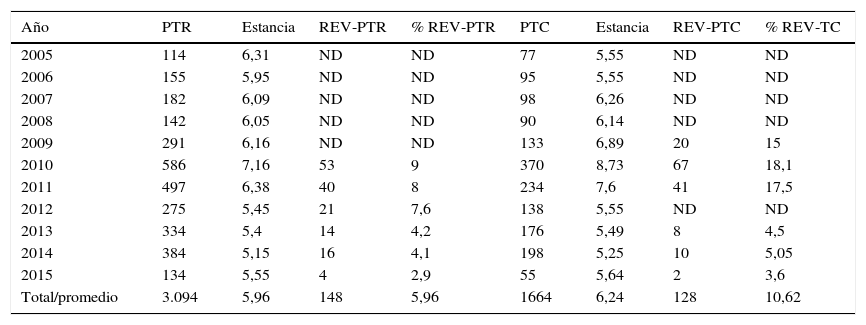a) Valorar la efectividad de la implementación del fast-track en PTR-PTC; y b) evaluar la eficiencia en la estancia hospitalaria, las cirugías de revisión y los costes.
Material y métodosEstudio observacional en 2 tiempos:
1) Estudio prospectivo con 200 pacientes (PTR=100, PTC=100) en 2005-2007. Se analizó la edad, el sexo, la estancia hospitalaria, la escala visual analógica (EVA), el balance articular (BA) de rodilla, las complicaciones y la rehabilitación tras el alta.
2) Estudio prospectivo a 3.094 PTR y 1.664 PTC, desde el 2005-2015. Se analizó la estancia hospitalaria, el porcentaje de cirugías de revisión y el ahorro estimado.
ResultadosEn la validación en PTR el 68% (n=68) eran mujeres y el 32% (n=32) varones. La edad media fue de 71 años y la estancia hospitalaria de 6 días. La EVA preoperatoria/6 meses/año/2 años disminuyó progresivamente (7; 1,8; 1,4 y 1,2). El BA al alta/mes/2 años mejoró progresivamente (82°, 90° y 93°). Complicaciones 3% (n=3; fractura postraumática y 2 inestabilidades). Rehabilitación ambulatoria 8% (n=8). En la validación en PTC el 48% (n=48) eran mujeres y el 52% (n=52) varones, con una edad media de 70 años. La estancia hospitalaria fue de 5 días. Hubo complicaciones en 3 pacientes (3%) (fractura, luxación y TVP). Rehabilitación ambulatoria 3% (n=3). En PTR la estancia media (11 años) fue 5,96 días, las revisiones 5,96% y el ahorro estimado (2013-2015) 117.776 euros. En PTC la estancia media (11 años) fue 6,24 días, las revisiones 10,62% y el ahorro estimado (2013-2015) 116.316 euros.
ConclusionesLa implantación/seguimiento del protocolo fast-track en PTR-PTC disminuye el dolor, las complicaciones, la rehabilitación ambulatoria, la estancia hospitalaria, la tasa de revisiones y los costes.
a) To validate the effectiveness of the implementation of a fast-track protocol for TKA-THA; b) to evaluate efficiency in reducing length of stay, hospital costs and revision surgeries.
Material and methodsA two-phase observational study was performed:
1) A prospective study in 200 patients (100 TKA and 100 THA) between 2005 and 2007. Age, sex, length of stay, visual analog scale (VAS) for pain, knee range of movement (ROM), complications and post-discharge rehabilitation were analyzed.
2) A prospective study was conducted in 3094 TKA and 1664 THA patients between 2005 and 2011. Length of stay, revision surgery and estimated savings were analyzed.
ResultsIn the TKA evaluation, 68% of the patients were female (n=68) and 32% were male (n=32). The mean age was 71 years. Length of stay was 6 days. Pain diminished progressively at discharge/6 months/1 year/2 years (7; 1.8; 1.4 and 1.2), respectively. The ROM progressively increased at discharge/1 month/2 years (82°, 90° and 93°), respectively. The complications rate was 3% (n=3) (fracture and instability). Ambulatory rehabilitation was provided in 8% (n=8). In the THA evaluation, 48% of the patients were female (n=48) and 52% were male (n=52). The mean age was 70 years. Length of stay was 5 days. The complications rate was 3% (n=3) (fracture, dislocation and deep vein thrombosis). Ambulatory rehabilitation was provided in 3% (n=3). In TKA (11 years), the length of stay was 5.96 days, revision surgeries were carried out in 5.96%, and the cost saving in 2013-2015 was 117,776 euros. In THA (11 years), the length of stay was 6.24 days, revision surgeries were performed in 10.62%, and the cost saving in 2013-2015 was 116,316 euros.
ConclusionsThe implementation/follow-up of the fast-track protocol in THA-TKA was effective in decreasing pain, complications, ambulatory rehabilitation, length of stay, the rate of revision surgery, and costs.
Artículo
Comprando el artículo el PDF del mismo podrá ser descargado
Precio 19,34 €
Comprar ahora















